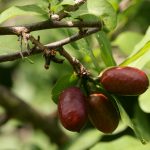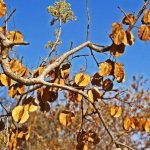TREE LIFE
AUGUST 1989
MASHONALAND CALENDAR
Saturday 5th August: Botanic Garden Walk. Meet in the car park at 1045 hours for 1100 hours. Tom Muller will be our host provided his return to Zimbabwe is not delayed.
August 11th, 12th and 13th : Heroes Weekend at Culenborg, Arusha Estate at the Vumba
The deadline for reserving accommodation at Arusha Estate is August 1st. Please phone Maureen Silva Jones at work on 739711, Harare.
We hope that travellers from Harare will have recovered sufficiently from the long drive to enjoy a shortish botanising ramble in Mr and Mrs Vermeulen’s own forest on Arusha Estate. Let’s meet on Friday afternoon at 1400 hours at Arusha Estate.
The mood and the weather will dictate our activities on Saturday and Sunday. It may be the Bunga forest or a special spot known by local members – whatever – we will meet at 0900 at Arusha Estate on both days. Come prepared with a picnic lunch.
The Bulawayo and Ayrshire branches will be represented on this trip and we are looking forward to meeting all you Mutare and Vumba members.
Sunday 20th August : An own cars outing to Charles and Bridget Newmarsh’s farm Chibvuti in the Enterprise Arcturus area. Lots of trees and game on this beautiful farm, so an outing not to be missed. Meet on the farm at 1000 hours
Saturday 26th August : Mukuvisi Woodlands Walk. Meet Mark at the Paget Road/Inyanga Crescent gate at 1500 hours.
MATABELELAND CALENDAR
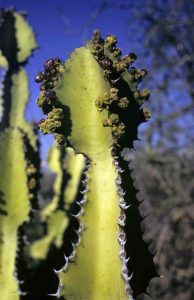
Euphorbia confinalis. Photo: Darrel Plowes. Source: Flora of Zimbabwe
On Sunday August 6th we go to the Hendriks Pass area, via the Figtree Road, to see some Euphorbia confinalis, then on to Zilozwana and back through the Matopos. Meet at 0830 at Graphotype, 81 Mafeking Road, opposite Merlin where cars may be left safely.
On Sunday September 3rd we go to Kanyama Farm, Mr. G.C. Acutt, some 29 km down the Queens Road.
MATABELELAND NOTES
On Sunday, 2nd July we went to the Fort Rixon area, to Engomeni Game Reserve, Mr. Mickey Parker i/c, where Meikles are starting a Game area. We saw quite a few Tsessebe and Zebra, and occasionally managed to mark and number some trees. In all we noted some 55 species of tree, while driving around. There was much more leaf than we expected, and some fine trees were seen, pods and other fruit being prominent everywhere. The area would be well worth further tree study, being both sand and red soil.
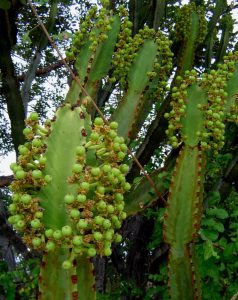
Euphorbia ingens. Photo: Bart Wursten. Source: Flora of Zimbabwe
Four Acacia types were noted : A. galpinii and A. nigrescens grew very tall on the red soil, we also saw many A. karroo and A. rehmanniana, and met some fine Brachystegia glaucescens, the Mountain “Acacia” a name illustrating the futility of some popular names! They are confined to summits and slopes of rocky hills, and not often seen round here, also we saw Canthium huilense that was, now Psydrax livida, Carissa edulis, Catha edulis, Combretum molle, some large and red Combretum imberbe, leadwood, Commiphora schimperi, Dichrostachys cinerea, some differing a little from the norm, with larger, softer leaflets, and pods much less curled, Diospyros lycioides, Erythrina latissima, Euclea natalensis, quite tall Euphorbia ingens widespread, three figs, Ficus sur – capensis, F. glumosa –sonderi, F. thonningii – natalensis and some very large square stemmed Grewia flavescens and G. monticola, many and widespread, Julbernardia globiflora, all showing a fine display of pods on the tops, Mundulea sericea, tallish and well fruited, Ozoroa insignis subsp reticulata, Pavetta schumanniana, leaves very shiny thick, some tall well fruited mukwa, Pterocarpus angolensis, P. rotundifolius, Rhus lancea, Rhus leptodictya, leaf margins extra well scalloped, Sclerocarya birrea – caffra, Strychnos spinosa with plentiful fruit, Tarenna neurophylla, Terminalia sericea, T. trichopoda, Turraea nilotica, Vangueria infausta, Ximenia americana.
We had a good turn out and membership is increasing quite a bit thanks to our Chairman’s efforts!
-C. Sykes
BOTANIC GARDEN WALK 1ST JULY 1989
We are most grateful to Bob Drummond who stepped in at short notice, lets be honest, no notice, and gave us a most interesting hour and a half in the garden.
We started off at the pond, moved through an area of mainly riverine species, and finished at the trees of economic importance.
A very vigorous Ficus verruculosa growing adjacent to the pond was a rather different article than that which we normally come across on the Highveld (remember Chabweno Farm, Enterprise, September 1988) which is a very low growing tree invariably found near rivers and covered with brilliant red fruit at the right time of the year. The one that we examined in the Garden had formed a thicket, characteristic of those found in the Okavango Delta. The “verrucas” in the underside of the leaves were not to be found.
A little further on we examined some plants that grow in the pond such as Salvinia molesta, a water fern with buoyancy assisted by massed hairs on the leaves. A species of AESCHYNOMENE grew well with its feet in the water, bearing a few yellow pea flowers to confirm that it belonged to FABACEAE. Cyperus papyrus, the big daddy of all those small but attractive grass like plants that grow on the veld, seemed to enjoy being there, and lording it over all these was our own indigenous water lily Nymphaea petersiana, its blue flowers always a pleasure to see.
Continuing along our replica of a riverine valley we examined Trichilia emetica (not very happy, this one), Phoenix reclinata, many stemmed from the base, and Syzygium guineense subsp. barotsense distinguished from our local subspecies by the fact that its fruit is white and not purple. We flirted in passing with some mysterious exotics, Ficus cyathistipula, with a spongy fruit just made for river transportation and Burtt-davya nyasica from guess where? – and with almost circular hairy fruits. Terminalia zambesiaca brought us back home with its markedly clustered leaves and large fruits, as did Citropsis daweana, another RUTACEAE that is found in the Valley.
Now it was getting nearer lunch time and Bob, generous to a fault, offered us Camelia sinensis (not everybody’s cup of tea, but there was no indica), Olea europaea subsp. europaea (Noah recognised it, even if you can’t). Elaeis guineensis (useful to know when palms need to be oiled), Ceratonia siliqua (St. John’s bread or Carob), Manihot aipi (anyone for tapioca) and Bob’s favourite, if he can get there before the doves and Tree Society members, Havenia dulcis with its raison life fruits.
Thank you Bob for looking after us so well.
WALK AFTER THE AGM AT RUWA CLUB
May was the month chosen for the AGM and we were fortunate to be able to hold it at the Ruwa Club. After the meeting we sauntered onto the golf course to have a look at the trees, everybody having first been cautioned to watch out for flying golf balls. Out first stop was at a clump of Parinari curatellifolia which are such a feature of the landscape in the Ruwa area. They are in the family CHRYSOBALANACEAE and their common name is muhacha or mobola plum. They are characteristic of sandy soils and have a rather unpleasant smell at times. This particular bunch were no exception and the Tree Society members were to be seen sniffing the bark of the trees to see if that was a possible source.
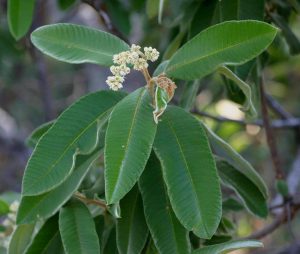
Ozoroa insignis. Photo: Bart Wursten. Source: Flora of Zimbabwe
The other trees we saw in the vicinity of the golf course were Ozoroa insignis (family ANACARDIACEAE –the avocado family), Ekebergia banguelensis which is related to syringa (Melia azedarach) a wonderful specimen of Securidaca longipedunculata (the wild violet tree) in fruit, a large specimen of Albizia antunesiana which we usually see as a young plant with purplish leaves, and Pavetta gardeniifolia and P. schumanniana (family RUBIACEAE) growing side by side. The dark spots in the leaves of the last two were clearly visible when held up to the light. At this point everyone was starting to feel rather hungry so we meandered back to our cars and set off for the home of Mr and Mrs Hardy where we had our lunch in the lovely shade.
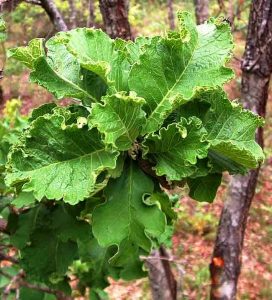
Turraea nilotica. Photo: Rob Burrett. Source: Flora of Zimbabwe
After lunch we looked round the garden where there were some most impressive sights. The first tree we looked at was Dodonaea viscosa looking rather shrub like. It has very light green leaves and belongs to the family SAPINDACEAE. Maesa lanceolata which is very characteristic of wet places was also in the garden – probably because there was a dam very near by. Having looked at those two we went to the swimming pool where we had been promised that there would be something really worth seeing. There were three things : a large Steganotaenia araliacea (the pop gun tree), a large Albizia antunesiana, and the highlight of the day, the biggest Turraea nilotica (family ANACARDIACEAE) that any of us had ever seen. The leaf has a midrib which looks as if it has been pulled to gather it up slightly. At the side of the drive we saw Diospyros lycioides, the star apple tree, family EBENACEAE, the roots of which are sometimes chewed after a meal, dying the mouth red and they are also sometimes used as toothpaste.
We then left the garden and started to walk down the road where we saw Rhoicissus tridentata, family VITACEAE, climbing over a tree, Senna singueana with little yellow bee stings, a lot of Burkea africana with rusty hairs at the ends of the branches, Dichrostachys cinerea with its characteristic seed pods, Maytenus senegalensis, family CELASTRACEAE, in flower, Protea angolensis and P. gaguedi, Pseudolachnostylis maprouneifolia, Uapaca kirkiana, family EUPHHORBIACEAE, which is indicative of a frost free area, and our old friend Psorospermum febrifugum.
It was a lovely day and our thanks go to the Ruwa Club and to Mr and Mrs Hardy for allowing us to look at their wonderful trees.
-Barbara Browning
OUTING TO CHEGUTU 18TH JUNE 1989
Anne Bianchi gave us a foretaste of things to come in Tree Life No. 110. the event lived up to the promise and about twenty hardy souls met up with a smaller party from the Chegutu area on a day that started off cold but warmed up nicely as time went by. Anne led the outing.
The approach to the Clifton-Off-River Storage Dam from Selous led us over flat farmland with light, sandy soil and occasional rocky ridges of banded iron stone which bore silent witness to the volcanic upheavals in the dim past. Although winter is upon us there is still an array of attractive colours in the bush. Terminalia sericea, with milk chocolate coloured fruit, Combretum adenogonium turning red-bronze. Loranthus high in the trees, does it never stop flowering? Pterolobium stellatum flashing red warning signs via its winged seeds. Senna singueana starting to show bright yellow and another yellow provided by the poisonous fruit of Solanum sp.
The dam, where we met, was constructed about two years ago, somewhat to the surprise of the farmer who had not been told anything about it. Bureaucracy moves in strange ways. The farm has been in the hands of the same family since 1896, so there had obviously been time to make the intention known. The dam has been erected to store water pumped from the Mapfure River, a reserve needed to ensure the water supply to Chegutu and a nearby Defence Force establishment.
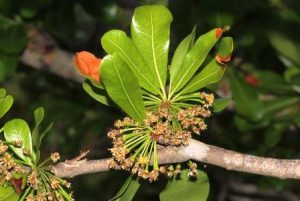
Canthium frangula. Photo: Bart Wursten. Source: Flora of Zimbabwe
We finished the day with 105 ticks on the field card, plus several samples for verification. Of particular interest to the Harare contingent was the abundance of Canthium frangula, with paired spines and lax, flowing branches. Equally abundant was Hippocrates parvifolia, which apparently can’t make up its mind whether it wants to be a tree or a liana, using any neighbouring species to lean on to gain height. Several large Manilkara mochisia were outstanding, and we had a chance to admire fruit of Rothmannia fischeri which not many of us had seen before. Another ‘newy’ to most was Haplocoelum foliolosum with quite the most asymmetric leaflets you have ever seen.
And then there was the curious creeper with a winged stem, named by one of the more irreverent members of the party “Dinosarus” a name that is pictorially valid but scientifically suspect.
Thank you, Anne and Nina, for giving us such an interesting day.
SUNDAY 16TH JULY : CHEDGELOW FARM
In the window of a little car the other day I noticed this label “Its not a sin to be rich, it’s a miracle”. Why is it that we always count riches in terms of that ‘elusive butterfly’ when all around us there are real flesh and blood butterflies, birds, flowers and trees and all the bounties of nature that make us so rich in every sense (sight, hearing, smell, taste and touch).
These riches were abundant on our visit to the “chabaudii fairyland” in the typical Highveld countryside near Harare, sadly most of the delicate aloe flowers had faded, but here and there they still brightened the woodland. No wonder they thrive there in the fire free frost free shelter of the granite rocks. The anticipation of every tree outing is to find the unusual, so what’s new in this area anyway. Strange – there was never a dull moment and indeed a few surprises.
The path into the woodland led through granite rocks and we could not but stop to admire the large wayside trees; Strychnos cocculoides, the fruits of which are sweet and edible and not poisonous as the name may imply; apparently the seeds of an Indian species do contain strychnine. A large Burkea africana, surprisingly unspoilt – what a pity this tree is host to a species of caterpillar much relished by the people resulting in its destruction time and again. It is even called “mukarati” – the tree of the caterpillars. Not often do we see such a collection of amusing pods on the Indigofera rhynochocarpa, the tip of the pod hooks upwards like a beak resembling a hockey stick. A large Ozoroa insignis, tar berry, with tiny rosebuds of Crassula growing in its rough flaky bark grew next door to a Ziziphus mucronata, the less innocuous of the two species Ziziphus mauritiana being the one bearing the fruit used in the brewing of “Kachasu”. This tree caused some amusement, not entirely tree-wise, in that it was home to a colony of “cock tail ants” – not the drink as we immediately surmised, but named from the way these tiny insects curl up their tails capped with a deadly sting ready for battle with any enemy.
The attractive amphitheatre area had recently been cleared for musical concerts and strategically framing the minstrel galley are four handsome bearded Aloe excelsa. No wonder Reynolds called it a “noble plant” with its lovely inflorescences, dark maroon panicles, reaching into the sky.
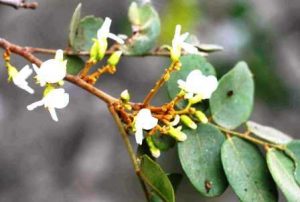
Dalbergia nitidula. Photo: Bart Wursten. Source: Flora of Zimbabwe
Mr and Mrs Dankwertz joined us for a short while and Mr Danckwertz asked us to identify a tree standing at the edge of the circle which he described as having a mass of beautiful white flowers in spring. This is indeed so, for it is a Dalbergia nitidula, the purple wood dalbergia, and even the green tree book waxes enthusiastic enough to mention ‘flowers, white, appearing just before the rains making quite a spectacular show.’
On the left of the gallery grows a tall Cassia abbreviata with extremely long pods hanging down. If you think that ‘abbreviata’ is a misnomer this applies to the flowers which are rather abbreviated! And the very optimistic tree growing out from under the rocks along the ground and then into the sunlight at a right angle is a Euclea natalensis of the Ebony family. A quick look at the side of the gallery revealed a Maytenus undata and here our sense of smell certainly stood us in good stead; rub a leaf between thumb and finger and a distinct “musty’ smell assails your nose, no mistaking that. We also found a very heavily seed laden Canthium lactescens with larger than usual interpetiolar stipules, which when squeezed yielded up a white gummy fluid – hence lactescens. It is fun identifying the family RUBIACEAE and finding the interpetiolar stipules of which I think this Canthium has easily the largest. Close by is another member of this family, Tricalysia angolensis, scaly-bark tricalysia, which remains in bud for eleven months of the year; small greenish white buds in dense tight axillary clusters along the slender branchlets. Phil says he has never seen a flower.
The afternoon walk led us towards the swamp area. En route we discovered close together Cordia sinensis, multi trunked grey-green and with leaves that felt like sand paper, and Pappea capensis, with lovely fresh apple green serrated leaves. The fruit of this tree is a furry green capsule akin to miniature leechies and they are quite edible. It was not difficult to identify the trees even in mid winter for they all had leaves or pods. The only two trees which were completely naked were the Lannea discolor and the Pterocarpus angolensis, but here too a fine specimen had neglected to shed its furry pods at the very top of the tree.
The medicine man had been at work on the Pterocarpus for a piece of bark had been cut away to release the dark red blood so prized by the ‘ngangas’. The yellow blood Garcinia buchananii had fared better; this tree is all yellow and the flowers greenish yellow, the fruit which does contain Vitamin C, the wood yellow and the sap which oozes out when you break a leaf is most distinctly yellow.
The highlight of the day –casually sprawling over the top of low granite rock was a Ficus verruculosa (water fig) unmindful of how attractive it looked, a mass of small red/yellow figs not quite ripe and still to turn bright red. Verruculosa is the specific name and refers to the leaves which are thick and leathery and speckled with small warty encrustations (i.e. verruca – a wart). The little figs also have a rather scaly skin and the apical pore is slightly raised. We found another interesting swamp plant; a large clump of yellow and light green leaves growing close to the ground was a water berry, the dwarf species Syzygium huillense. These plants have a very characteristic growth under the ground which allow them to regenerate themselves in case of damage by fire.
When the human traffic left the amphitheatre in the late afternoon a little mongoose searched to find any titbits left after lunch; what a pity it did not make its presence known earlier when a goodly portion could have been placed on the rocks for it. Soon the hoarse calls of a flock of knob billed duck flying home to the dam made us realise that it was getting late and we, too, should be on our way.
Thank you for allowing us to ramble through your lovely patch of woodland John and Stella Dankwertz and may be come again.
-Vida Siebert.
AYRSHIRE ROOTNOTE Have you ever done the prickle test? A prickle is superficial, its origin is exogenous, so it should rub off quite easily e.g. a rose prickle. A thorn or spine develops from within a plant, it is endogenous, it is difficult to break off. Structurally a thorn or spine is a modified or aborted branch, petiole, peduncle or stipule. Dichrostachys and Maytenus are examples of spinous plants, close inspection shows that their spines or thorns bear leaves and or buds, which indicate that they are modified branches.
The genus Ziziphus and some of the Acacias have spines in the position of stipules, these are called stipular spines. Some Acacias have stipules which are not spinescent, so that their armaments are called prickles; because they arise from the epidermis. Difficulty may arise when the prickle test is applied to Knob thorn’s knobby prickles … To avoid bloodshed it is advisable to choose semi-lignified twigs for these investigations.
Results can be recorded on a large sheet of paper with columns for
PRICKLES SPINES DOUBTFULS NOTES
This exercise will certainly increase knowledge of the finer points of plants. Flora Zambesiaca Vol. 3 Part 1 has a lot to say about prickles and spines. These definitions mentioned above make it necessary to revise the verse in Tree Life No. 107, page 6. Please delete line 3 because Acacia tortilis is included in “all the rest have spines”.
Apologies for this mistake and for misleading anyone.
-Benidicta Graves
DICK HICKS CHAIRMAN


